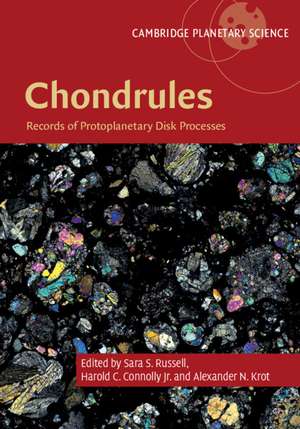Chondrules: Records of Protoplanetary Disk Processes: Cambridge Planetary Science, cartea 22
Editat de Sara S. Russell, Harold C. Connolly Jr., Alexander N. Kroten Limba Engleză Hardback – 18 iul 2018
Din seria Cambridge Planetary Science
-
 Preț: 401.86 lei
Preț: 401.86 lei - 14%
 Preț: 751.63 lei
Preț: 751.63 lei - 9%
 Preț: 871.58 lei
Preț: 871.58 lei - 8%
 Preț: 521.68 lei
Preț: 521.68 lei - 11%
 Preț: 579.05 lei
Preț: 579.05 lei -
 Preț: 458.24 lei
Preț: 458.24 lei - 14%
 Preț: 716.10 lei
Preț: 716.10 lei -
 Preț: 446.28 lei
Preț: 446.28 lei - 11%
 Preț: 506.54 lei
Preț: 506.54 lei -
 Preț: 337.66 lei
Preț: 337.66 lei - 14%
 Preț: 941.54 lei
Preț: 941.54 lei - 11%
 Preț: 587.99 lei
Preț: 587.99 lei - 14%
 Preț: 1260.55 lei
Preț: 1260.55 lei - 23%
 Preț: 1135.26 lei
Preț: 1135.26 lei -
 Preț: 353.83 lei
Preț: 353.83 lei - 14%
 Preț: 1033.36 lei
Preț: 1033.36 lei - 14%
 Preț: 908.92 lei
Preț: 908.92 lei -
 Preț: 446.87 lei
Preț: 446.87 lei - 11%
 Preț: 597.23 lei
Preț: 597.23 lei -
 Preț: 400.70 lei
Preț: 400.70 lei -
 Preț: 357.51 lei
Preț: 357.51 lei -
 Preț: 350.76 lei
Preț: 350.76 lei - 14%
 Preț: 1056.97 lei
Preț: 1056.97 lei - 19%
 Preț: 734.95 lei
Preț: 734.95 lei - 20%
 Preț: 474.96 lei
Preț: 474.96 lei
Preț: 826.95 lei
Preț vechi: 1079.14 lei
-23% Nou
Puncte Express: 1240
Preț estimativ în valută:
158.23€ • 165.21$ • 130.96£
158.23€ • 165.21$ • 130.96£
Carte indisponibilă temporar
Doresc să fiu notificat când acest titlu va fi disponibil:
Se trimite...
Preluare comenzi: 021 569.72.76
Specificații
ISBN-13: 9781108418010
ISBN-10: 1108418015
Pagini: 450
Ilustrații: 120 b/w illus. 16 colour illus.
Dimensiuni: 178 x 252 x 26 mm
Greutate: 1.07 kg
Editura: Cambridge University Press
Colecția Cambridge University Press
Seria Cambridge Planetary Science
Locul publicării:Cambridge, United Kingdom
ISBN-10: 1108418015
Pagini: 450
Ilustrații: 120 b/w illus. 16 colour illus.
Dimensiuni: 178 x 252 x 26 mm
Greutate: 1.07 kg
Editura: Cambridge University Press
Colecția Cambridge University Press
Seria Cambridge Planetary Science
Locul publicării:Cambridge, United Kingdom
Cuprins
List of contributors; 1. Introduction Sara. S. Russell, Harold C. Connolly, Jr and Alexander N. Krot; Part I. Observations of Chondrules: 2. Multiple mechanisms of transient heating events in the protoplanetary disk: evidence from precursors of chondrules and igneous Ca, Al-rich inclusions Kazuhide Nagashima, Guy Libourel and Kelly E. Miller; 3. Thermal histories of chondrules: petrologic observations and experimental constraints Rhian H. Jones, Johan Villeneuve and Guy Libourel; 4. Composition of chondrules and matrix and their complementary relationship in chondrites Dominik C. Hezel, Phil A. Bland, Herbert Palme, Emmanuel Jacquet and John Bigolski; 5. The chondritic assemblage: complementarity is not a required hypothesis Brigitte Zanda, Eric Lewin and Munir Humayun; 6. Vapor-melt exchange: constraints on chondrite formation conditions and processes Conel M. O'D. Alexander, Denton S. Ebel and Guy Libourel; 7. Chondrules in enstatite chondrites Emmanuel Jacquet, Laurette Piani and Michael K. Weisberg; 8. Oxygen isotope characteristics of chondrules from recent studies by secondary ion mass spectrometry Travis J. Tenner, Takayuki Ushikubo, Daisuke Nakashima, Devin L. Schrader, Michael K. Weisberg, Makoto Kimura and Noriko T. Kita; 9. 26Al-26Mg systematics of chondrules Kazuhide Nagashima, Noriko T. Kita and Tutu H. Luu; 10. Tungsten isotopes and the origin of chondrules and chondrites Thorsten Kleine, Gerrit Budde, Jan L. Hellmann, Thomas S. Kruijer and Christoph Burkhardt; 11. The absolute Pb-Pb isotope ages of chondrules: insights into the dynamics of the solar protoplanetary disk James N. Connelly and Martin Bizzarro; 12. Records of magnetic fields in the chondrule formation environment Roger R. Fu, Benjamin P. Weiss, Devin L. Schrader and Brandon C. Johnson; Part II. Possible Chondrule Forming Mechanisms: 13. Formation of chondrules by planetesimal vollisions Brandon C. Johnson, Fred J. Ciesla, Cornelis P. Dullemond and H. Jay Melosh; 14. Making chondrules by splashing molten planetesimals: the dirty impact plume model Ian S. Sanders and Edward R. D. Scott; 15. Formation of chondrules by shock waves Melissa A. Morris and Aaron C. Boley; 16. Evaluating non-shock, non-collisional models for chondrule formation Alexander Hubbard and Denton S. Ebel; 17. Conclusions Harold C. Connolly, Jr, Alexander N. Krot and Sara S. Russell; Index.
Descriere
An overview of state-of-the-art research into properties and possible formation mechanisms of chondrules, by leading cosmochemists and astrophysicists.
